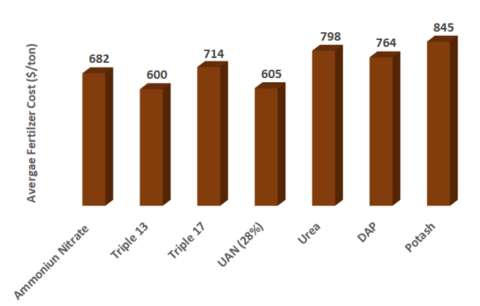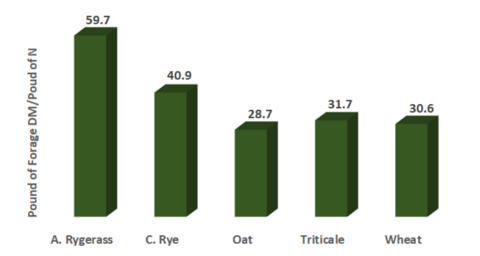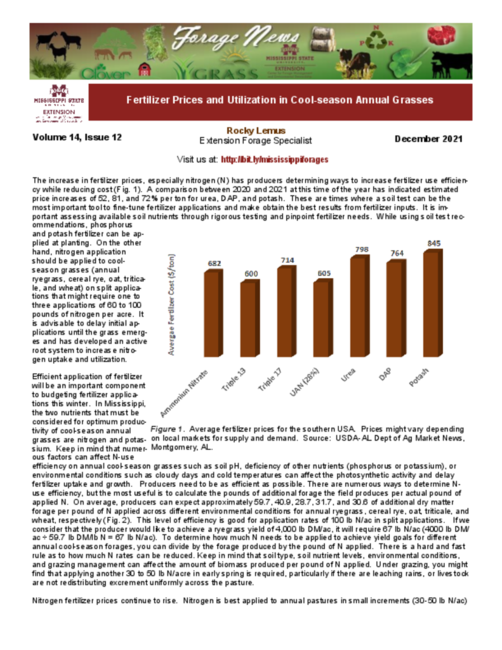Forage News
Fertilizer Prices and Utilization in Cool-season Annual Grasses

Efficient application of fertilizer will be an important component to budgeting fertilizer applica-tions this winter. In Mississippi, the two nutrients that must be considered for optimum produc-tivity of cool-season annual grasses are nitrogen and potas-sium. Keep in mind that numer-ous factors can affect N-use efficiency on annual cool-season grasses such as soil pH, deficiency of other nutrients (phosphorus or potassium), or environmental conditions such as cloudy days and cold temperatures can affect the photosynthetic activity and delay fertilizer uptake and growth. Producers need to be as efficient as possible. There are numerous ways to determine N-use efficiency, but the most useful is to calculate the pounds of additional forage the field produces per actual pound of applied N. On average, producers can expect approximately 59.7, 40.9, 28.7, 31.7, and 30.6 of additional dry matter forage per pound of N applied across different environmental conditions for annual ryegrass, cereal rye, oat, triticale, and wheat, respectively (Fig. 2). This level of efficiency is good for application rates of 100 lb N/ac in split applications. If we consider that the producer would like to achieve a ryegrass yield of 4,000 lb DM/ac, it will require 67 lb N/ac (4000 lb DM/ac ÷ 59.7 lb DM/lb N = 67 lb N/ac). To determine how much N needs to be applied to achieve yield goals for different annual cool-season forages, you can divide by the forage produced by the pound of N applied. There is a hard and fast rule as to how much N rates can be reduced. Keep in mind that soil type, soil nutrient levels, environmental conditions, and grazing management can affect the amount of biomass produced per pound of N applied. Under grazing, you might find that applying another 30 to 50 lb N/acre in early spring is required, particularly if there are leaching rains, or livestock are not redistributing excrement uniformly across the pasture.

Nitrogen fertilizer prices continue to rise. Nitrogen is best applied to annual pastures in small increments (30-50 lb N/ac) and uses multiple applications over the growing season. This is because actively growing plants can take up N very readily once it is in the root zone and can be translocated to the above growth of photosynthetically active plants. This means that grazing animals can significantly remove a portion of the applied N as protein. When using granular fertiliz-ers such as urea (46-0-0) or urea ammonium sulfate (33-0-0), applying the annual rate twice during the season (after seed emergence and after the first grazing cycle) is ideal. If using liquid urea ammonium nitrate (UAN, 32% solution), then it might be best to reduce application and do at least three applications during the season. These products are less susceptible to volatilization during the winter months. Although there is an option to apply urease inhibitors to urea or UAN to reduce N volatilization, their effectiveness has not been extensively tested under winter conditions. These prod-ucts can add to the cost of the N fertilizer, and the added expense needs to be weighed against the potential of improv-ing subsequent N-use efficiency and forage productivity. Some producers also are relying on poultry litter as a nitrogen source. However, N content and availability are highly variable and most of the N is trapped in the organic matter. Keep in mind that breaking organic matter requires microbial activity which is diminished by cold temperatures. Be sure to base poultry litter application rates on a nutrient test and complement with chemical fertilizer sources as needed.
Cool-season annual forage grasses are well adapted to most climatic regions of Mis-sissippi and can have levels of forage production, but their choice is largely de-pendent on the producer’s management philosophy and livestock production needs. The maximum forage pro-duction is generally a func-tion of soil texture, soil mois-ture, planting date, planting method, and fertility. Nitro-gen influences the productiv-ity and quality of cool-season annual grasses depending on forage species. Nitrogen applications should include 60 to 100 pounds of nitrogen per acre in split applications after establishment followed by another application in the spring. Higher N applications beyond this recommendation might not be economically justi-fiable. Little nitrogen is usually lost from cool-season pastures under these guidelines and lowering N applications rates may be a suitable strategy to manage risks associated with escalating fertilizer prices. Given the high fertilizer costs, applying nitrogen or other fertilizers without a soil test will become more costly. A priority should be to evaluate your ferti-lizer needs and focus on a program that could help reduce unnecessary fertilizer applications.
Upcoming Events
Sheep and Goat Production Webinar Series (6:00 PM to 7:00 PM CST)
Registration Required
January 4, 2022— Converting Performance: Improving Productivity Through Sheep and Goat Selection for a Successful Operation
Register here
Jan 18, 2022— Addressing Reproductive Issues in Goats
Register here
For upcoming forage related events, click here.
Authors
-
 Extension/Research Professor
Extension/Research Professor- Plant and Soil Sciences
